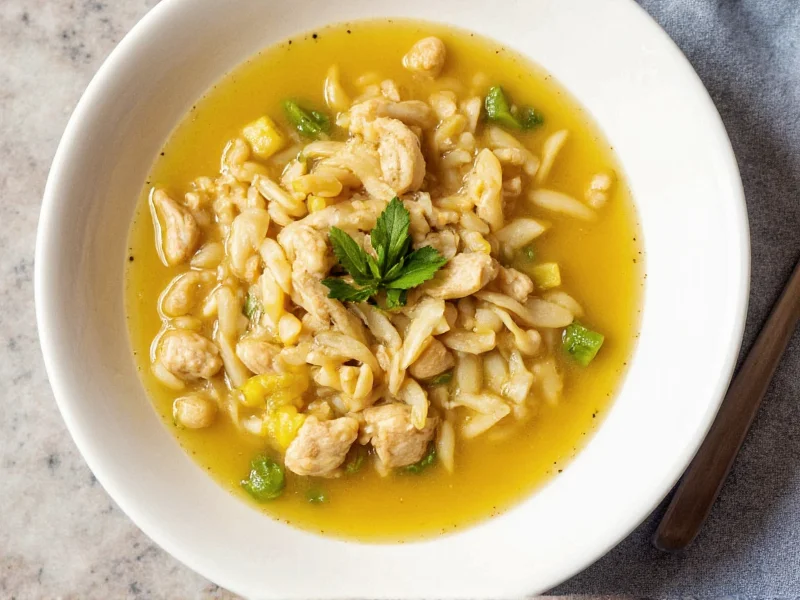If you've ever wondered what makes lemon chicken orzo soup Greek, the answer lies in its foundation: avgolemono. This classic Greek technique transforms simple ingredients into something extraordinary. Unlike Americanized versions that might use cream, authentic Greek lemon chicken soup relies on the magical emulsion of egg yolks and lemon juice to create a velvety, tangy broth that defines this beloved Mediterranean comfort food.
The Authentic Greek Connection
Many confuse Greek lemon chicken soup with standard chicken noodle soup with a lemon twist. True Greek avgolemono (meaning "egg-lemon" in Greek) has ancient roots tracing back to medieval times when egg-lemon sauces preserved food before refrigeration. The addition of orzo—rice-shaped pasta ubiquitous in Greek cuisine—creates a heartier variation perfect for cooler months while maintaining the dish's essential character.
What separates authentic Greek lemon chicken orzo soup from imitations? Three critical elements:
- The emulsion technique (never boiling after adding egg-lemon mixture)
- Balanced lemon-to-egg ratio (typically 1 lemon per egg yolk)
- Use of homemade chicken broth for depth of flavor
Essential Ingredients Breakdown
While regional variations exist across Greece, these components form the backbone of traditional preparation:
| Ingredient | Traditional Role | Substitution Notes |
|---|---|---|
| Egg yolks | Creates emulsion base | Must use fresh eggs; no substitutes maintain texture |
| Fresh lemon juice | Provides signature tang | Bottled juice alters flavor profile significantly |
| Homemade chicken broth | Flavor foundation | Store-bought requires enhancement with herbs |
| Orzo pasta | Traditional Greek pasta | Risoni is authentic Greek name; rice works in pinch |
Step-by-Step Preparation Guide
Follow this method for perfect Greek lemon chicken orzo soup every time. Total preparation: 45 minutes.
- Prepare broth base: Simmer chicken thighs with onions, celery, carrots, and bay leaves for 30 minutes. Remove chicken, shred meat, and return to broth.
- Cook orzo: Add ½ cup orzo directly to simmering broth. Cook until al dente (8-10 minutes).
- Create avgolemono: Whisk 3 egg yolks with ¼ cup fresh lemon juice until pale yellow.
- Temper eggs: Slowly ladle 1 cup hot broth into egg mixture while whisking constantly.
- Emulsify: Return tempered mixture to pot, stirring constantly over LOW heat (never boil).
- Finish: Stir in fresh dill and parsley. Rest 5 minutes before serving.
Avoiding Common Pitfalls
Even experienced cooks make these mistakes with Greek chicken soup with lemon and orzo:
- Boiling after adding egg mixture: Causes curdling. Maintain temperature below 160°F (71°C).
- Using bottled lemon juice: Lacks brightness and contains preservatives that affect emulsion.
- Overcooking orzo: Becomes mushy. Add pasta late in cooking process.
- Incorrect lemon-egg ratio: Too much lemon prevents proper emulsification.
Serving Traditions and Pairings
In Greece, avgolemono often serves as both starter and restorative meal. For authentic presentation:
- Serve immediately in pre-warmed bowls (heat maintains emulsion)
- Garnish with additional fresh dill and lemon slices
- Pair with Greek salad (horiatiki) and crusty bread
- Enjoy with a glass of Assyrtiko white wine from Santorini
This traditional Greek chicken soup with lemon and orzo works equally well as a light lunch or elegant starter for formal dinners. The bright acidity cuts through rich main courses beautifully.
Variations Across Greece
Regional adaptations showcase Greece's culinary diversity:
- Athens style: Includes capers and extra dill for sharper profile
- Island variation: Adds seafood like shrimp or mussels
- Northern Greece: Incorporates wild greens like vlita (amaranth)
- Fasting version (navy style): Uses vegetable broth during religious observances
Storage and Reheating Best Practices
While best served fresh, proper storage maintains quality:
- Refrigerate for up to 3 days in airtight container
- Freeze broth and solids separately (avgolemono doesn't freeze well)
- Reheat gently over low temperature, adding splash of water if needed
- Never microwave directly—use double boiler method for best results
Revive day-old soup by tempering fresh egg-lemon mixture into reheated broth. This easy Greek lemon chicken orzo soup adaptation maintains authenticity while accommodating modern schedules.
What makes lemon chicken soup Greek?
The defining element is avgolemono—the traditional Greek emulsion of egg yolks and fresh lemon juice that creates the soup's signature tangy, velvety broth without cream. This technique dates back centuries in Greek culinary tradition and distinguishes authentic versions from imitations.
Can I use rice instead of orzo in Greek lemon chicken soup?
Yes, but with caveats. Traditional Greek versions use orzo (called risoni in Greece), but short-grain rice works as substitute. Add rice earlier in cooking (15-20 minutes) since it requires longer than orzo. Avoid long-grain rice as it becomes too soft in the acidic broth.
Why did my Greek lemon chicken soup curdle?
Curdling occurs when the egg-lemon mixture is exposed to high heat. Always temper the avgolemono by slowly adding hot broth while whisking, then return to pot over LOW heat without boiling. The critical temperature threshold is 160°F (71°C)—exceeding this causes curdling.
Is traditional Greek lemon chicken soup gluten-free?
The base avgolemono technique is naturally gluten-free, but traditional versions with orzo are not. For gluten-free preparation, omit pasta or use certified gluten-free orzo alternatives. Many Greek households serve avgolemono as a clear soup during religious fasting periods without any pasta.











 浙公网安备
33010002000092号
浙公网安备
33010002000092号 浙B2-20120091-4
浙B2-20120091-4